Submitted by Gitie on 6 June, 2010 - 14:24
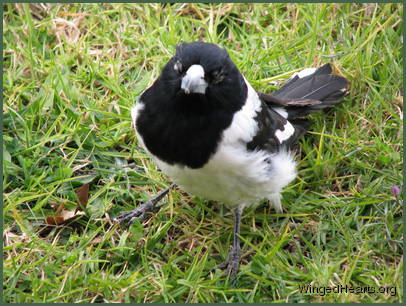 Pied butcherbirds are prone to conjunctivitis, much more so than their cousins the grey butcherbirds. According to the experts the problem is quite common in the wild with many species falling victim. We've seen a currawong and even a crow succumbing to this problem.
Pied butcherbirds are prone to conjunctivitis, much more so than their cousins the grey butcherbirds. According to the experts the problem is quite common in the wild with many species falling victim. We've seen a currawong and even a crow succumbing to this problem.
First a crust forms on one eye causing inflammation of the eyelid and eye. If left untreated, it can spread to the other eye as well. The bird can't open its eyes and can't find food and so slowly starves to death. He/she can't see where it's flying and can crash into trees, buildings and other objects injuring itself badly in the process. Nor can the bird get to safety out of the way of predators. The disease can even cause the bird to go irrecoverably blind.
Butchie (left) got a very bad attack a few years ago and lost sight in both eyes. Vets will not treat a bird they can't see so there was little we could do to help. Her son had got a milder attack before and we had treated it with a general antibiotic and vitamins and he fully recovered in two weeks. But these did not work on Butchie and we had no way of trapping her. All the other birds understood.

Submitted by Gitie on 5 June, 2010 - 19:40
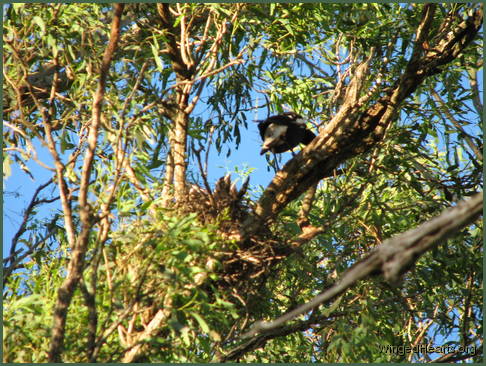 In this picture Vicky magpie has just landed on the branch with some food for the young chicks in her nest.
In this picture Vicky magpie has just landed on the branch with some food for the young chicks in her nest.
The start of winter, i.e. June is the mating season for magpies. By July the early breeders will have laid their eggs which usually hatch 4 weeks later. The young hatchlings spend a month in the nest developing and growing before they fledge.
Vicky is a late breeder. She doesn't lay her eggs until September and it is well into October before we see her fledgelings.
Magpies tend to keep the same nest over the years unless it is destroyed in a storm or other extreme circumstances. But Vicky has changed her nest quite often.
The most remarkable time was when a few years ago she swapped nests with a crow. The crows nests are bigger and stronger and she immediately got to work to line and soften the inside. The crow on the other hand lost no time in reinforcing Vicky's old nest and making it more

Submitted by Gitie on 4 June, 2010 - 13:24
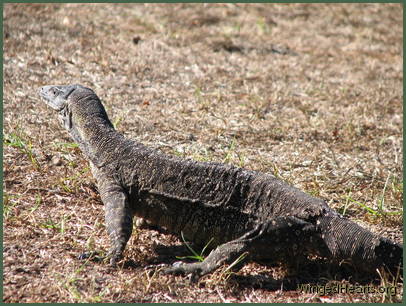 I'm going to detract from the birds and tell you about the goanna today. They are also called the Australian Monitor Lizard. They are predatory creatures and hunt for birds, eggs, snakes, smaller lizards and insects. they often take chicks and eggs out of birds' nests or catch a bird when its resting.
I'm going to detract from the birds and tell you about the goanna today. They are also called the Australian Monitor Lizard. They are predatory creatures and hunt for birds, eggs, snakes, smaller lizards and insects. they often take chicks and eggs out of birds' nests or catch a bird when its resting.
Needless to say, they are not a bird's best friend. In fact the bird don't like them at all. The birds have a good warning system. If any bird catches sight of goanna, they alert everyone else. All the other birds come and help chase the goanna out of their territory. The goanna is clever at disguising itself. You will see from the slideshow (click here) that once they're up a tree, they blend so well with the bark that they are hard to spot.

Submitted by Gitie on 3 June, 2010 - 17:17
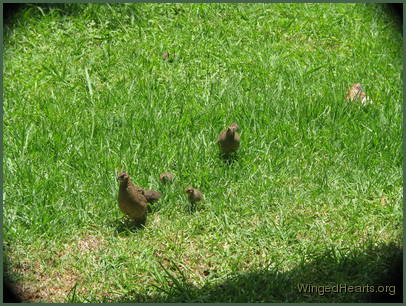 For the last two days I've been telling you about noisy-miners. Now the miners are considered to be one of the more aggressive birds in the country. They work in teams and families and can stand up to big birds like the crows and gang up on any bird who won't give into their demands (e.g the friarbirds).
For the last two days I've been telling you about noisy-miners. Now the miners are considered to be one of the more aggressive birds in the country. They work in teams and families and can stand up to big birds like the crows and gang up on any bird who won't give into their demands (e.g the friarbirds).
Quails on the other hand are considered to be very timid and extremely vulnerable. They have been easy targets for shooters and fall prey to predatory birds.
So imagine our surprise when a family of quails walked down from the grassy paddock into our backyard for a grand tour of the human habitat. The adults were so confident and proud of their little chicks who were barely days old. They inspected the bird baths, walked along the garden, checked out the undergrowth beneath the bushes, pausing every now and then to point significant items of interest to their young flock. They came right up to the back door and took a good long look inside. By the time I grabbed the camera and focussed through the glass, it was time for them to leave, so some of the shots

Submitted by Gitie on 2 June, 2010 - 13:29
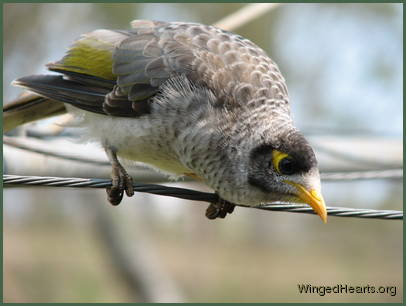 The magpies were the first birds we became friends with, even though they came into yard years after the noisy miners, peewees and pied butcherbirds.
The magpies were the first birds we became friends with, even though they came into yard years after the noisy miners, peewees and pied butcherbirds.
Minnie noisy-miner (left) initiated the friendship. For weeks she had been watching us talk to the magpies. The two species do not eat the same foods. Noisy-miners eat insects and nectar from the plants. They love the grevillea bushes (pictured below with a rainbow lorikeet), (experts liken it to a McDonalds for noisy-miners) and Minnie would spend hours hopping from flower to flower in our backyard. Magpies on the other hand are bug eaters - they like to potter on the ground digging out bugs and worms. They also like a bit of cheese and bread, which should only be given to them in small quantities as a supplement to their natural diet.

Pages

 Pied butcherbirds are prone to conjunctivitis, much more so than their cousins the
Pied butcherbirds are prone to conjunctivitis, much more so than their cousins the  In this picture
In this picture  I'm going to detract from the birds and tell you about the goanna today. They are also called the Australian Monitor Lizard. They are predatory creatures and hunt for birds, eggs, snakes, smaller lizards and insects. they often take chicks and eggs out of birds' nests or catch a bird when its resting.
I'm going to detract from the birds and tell you about the goanna today. They are also called the Australian Monitor Lizard. They are predatory creatures and hunt for birds, eggs, snakes, smaller lizards and insects. they often take chicks and eggs out of birds' nests or catch a bird when its resting. For the last two days I've been telling you about
For the last two days I've been telling you about  The
The 





